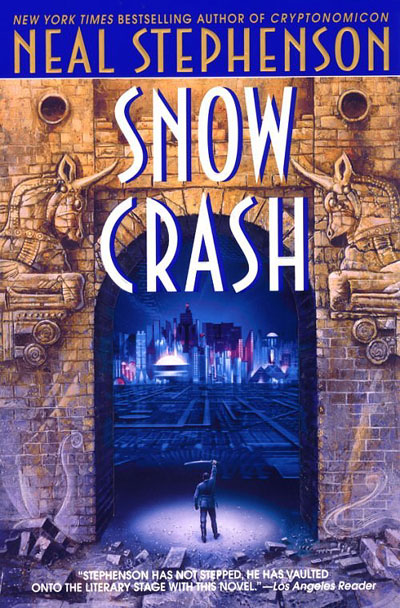The deliverator belongs to an elite order, a hallowed subcategory. He’s got esprit up to here. Right now, he is preparing to carry out his third mission of the night. His uniform is black as activated charcoal, filtering the very light out of the air. A bullet will bounce off its arachnofiber weave like a wren hitting a patio door, but excess perspiration wafts through it like a breeze through a freshly napalmed forest. Where his body has bony extremities, the suit had sintered armorgel: feels like gritty jello, protects like a stack of telephone books.
Page 1
Pokemon first made news in the US not for it’s addictive and silly characters, but because in 1997 it hospitalized hundreds of Japanese children. A scene filled the screen with flashes of light and induced seizures around the country. The phenomena is described as Photo Sensitive Seizures and inspired new TV regulations around the world.

The idea that seemingly meaningless visual input can cause the brain to misfire plays a key role in Stephenson’s prescient novel, Snow Crash.
The book began life as a graphic novel, but eventually the author turned to the more traditional format. It’s easy to see how the book would work as a comic. Stephenson describes the action and takes us into characters’ heads in ways the seem custom made for thought bubbles and six panel pages.
Stephenson wrote the book in 1991, when the Internet was something few people had heard of. There was no web and no point and click interfaces as there are today. No one could envision the DotCom nova that exploded 5 years later. The internet was still the province of email, FTP, USENET, Gopher, Archie, Veronica, and MUDs.
In this dark and funny dystopian cyberpunk novel, Stephenson weaves a complex plot covering Sumerian creation myths, commercialization and fragmentation of American culture, the collapse of the Soviet Union, Neuro-biology, the nature of linguistics, media ownership, 3rd world refugee migration, and modern Pizza delivery.
The book is filled with big ideas, including:
- Nature of computer viruses
- Nature of biological viruses
- Language Acquisition
- Hardware vs. Software vs. Wetware
- How homo sapiens became human beings
The history of creation myths and biblical stories
While filled with cool technology, ancient mythology, and enough violence and gore to make Rambo uncomfortable, Stephenson still writes it with his tongue planted firmly in his cheese. The first character we meet is a pizza delivery guy. How do we know he’s important to the story? Well, his name is Hiro Protagonist.
Last of the freelance hackers
Greatest sword fighter in the world
Stringer, Central Intelligence Corporation
Specializing in software-related intel
(music, movies, and microcode)
I had trouble with some of the ancient history. I probably should have been taking notes while reading it, because I kind of got lost in Hiro’s discussions with the Librarian. Fortunately, in chapter 56, Stephenson creates an expository section where he explains everything we would know if we had been paying attention. There are some elements in the book I still don’t grasp; it will take another reading or two.
A weakness of the book may be Stephenson’s hesitation. He doesn’t push his point to its logical end.
The story is about the parallels between biology and information. He treats the computer virus as though it’s different from the biological. He draws parallels between binary code and ancient ways of viewing the world. Mythical characters become programmers, but only in the metaphorical sense.
But it’s almost an arbitrary delineation. Biology IS information. Taken to the next level, there is no difference between the biological and the informational. They are the same. That’s the point he’s hinting at but he doesn’t quite take us there. I don’t know if that’s intentional, or if it’s because he wrote the novel in 1991.
“Neurolinguistic pathways in your brain. Remember the first time you learned binary code?”
“Sure.”
“You were forming new pathways in your brain. Deep structures. Your nerves grow new connections as you use them – the axons split and push their way between the dividing glial cells – your bioware self modifies – the software becomes part of the hardware.”Page 126
Juanita sighs, looks tired. “There won’t be any diagnosis,” she says. “It’s a software, not a hardware, problem.”
“Huh?”
“They’re rounding up the usual suspects. CAT scans, NMR scans, PET scans, EEGs. Everything’s fine. There’s nothing wrong with his brain – his hardware.”
“It just happens to be running the wrong program?”
“His software got poisoned.”Page 199
Since then, we’ve seen increasing convergence between technology and biology. From wireless headsets to the proliferation of portable computing to continual connections to the Internet to cutting edge limb replacement research, technology is a more integral and invisible part of our lives.
The book is not just big ideas, though. It’s also has some witty story telling. The pace is surprisingly quick. And Stephenson isn’t just focused on the technology. He brings out the emotion in his characters.
Some of the most moving sections on the story border on the cheesy and contrived, but are still a fun read. Chapter 65 tells a great story of the group camaraderie of strangers. And Fido’s story, which appears throughout the book, reminds us how being caring can pay unexpected dividends down the road.
In future entries, I may drill into some of the big issues. In the meantime, here are some topics for discussion in your next book group:
- The Raft is analogous to the brain with its quasi-organic growth and increasingly complex ties among constituent parts
- Biology is Data and vice versa
- How is the Internet like the Metaverse? How is it changing?
- What is the nature of language?
- Gargoyles are always connected. How is that like our culture today?
If you enjoy cyberpunk realities, dystopian futures, paleo-Christianity and ancient creation myths, or sword fighting, you will find something to enjoy in Snow Crash. It’s well paced, with a reasonably tight plot, compelling characters, and unexpected laughs. Readers can appreciate it based on big ideas, or on the engaging story. And I would look forward to a movie version of it, if I wasn’t convinced Hollywood would screw it up.

No comments:
Post a Comment